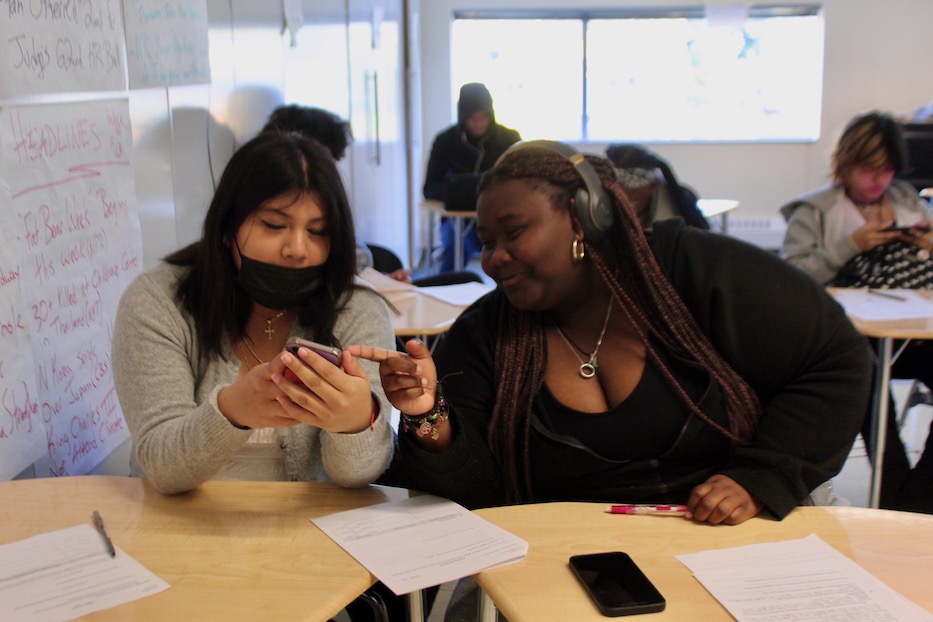
Culture & Community | Education & Youth | Arts & Culture | Journalism | Metropolitan Business Academy
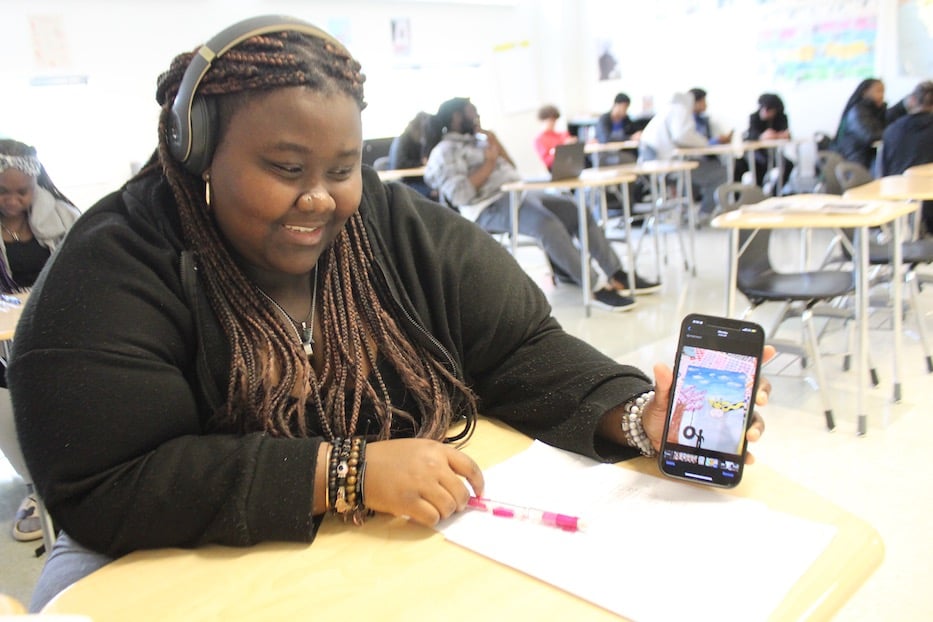
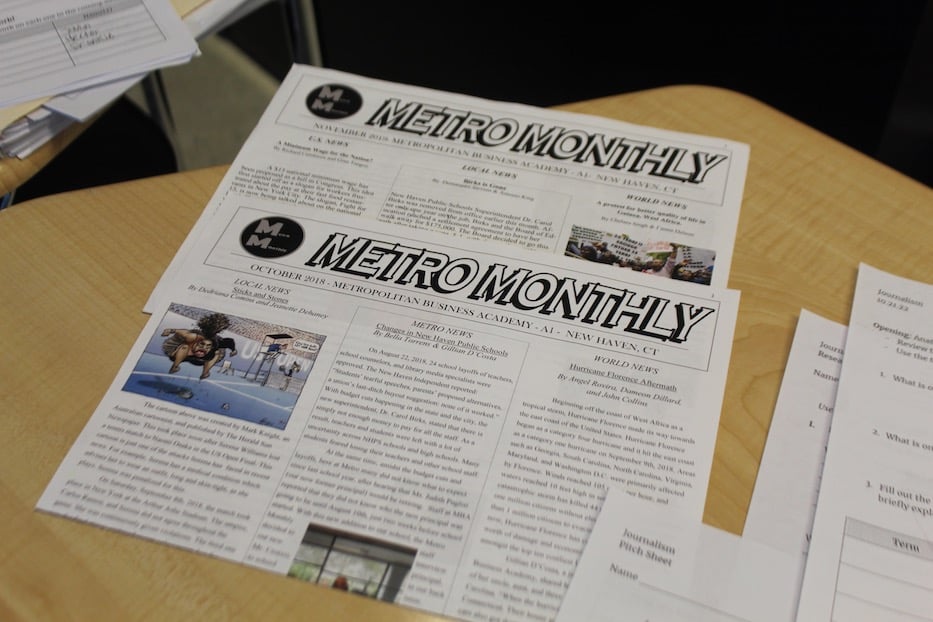
Andrea Bryant with one of the paintings from the library's makerspace that inspired her. Lucy Gellman Photos.
It was a little before 8 a.m. in Steve Staysniak’s journalism class, and still quiet enough to hear the rustle of papers, the skid of shoes in the hallway outside the door. Strains of conversation floated through the room, punctuated by the occasional burst of music from someone’s phone. A Newshound’s Guide to Student Journalism sat on a desk at the front of the classroom. On a projector, the day’s unsolved Wordle waited in yellow and white blocks of color. Room 204 was waking up.
Welcome the new offices of the Metro Monthly, a student newspaper at Metropolitan Business Academy that is revving back to life after an unwelcome pandemic hiatus. This month, Staysniak’s journalism students are jumping into the October/November issue with stories that range from teacher profiles to job classifieds to student takes on the cancellation of Kanye West. In the process, they’re building a sense of ownership over their school.
“I feel like the best thing about bringing the newspaper back is this is a good way to expose people to Metro,” said junior Andrea Bryant, who is covering student artists and the makerspace in the school’s library. “From the outside, people say, ‘Oh, that’s Metro. It’s a business school.’ When really inside, it’s something different. I feel like it doesn’t matter what school you go to, you can still have talent.”
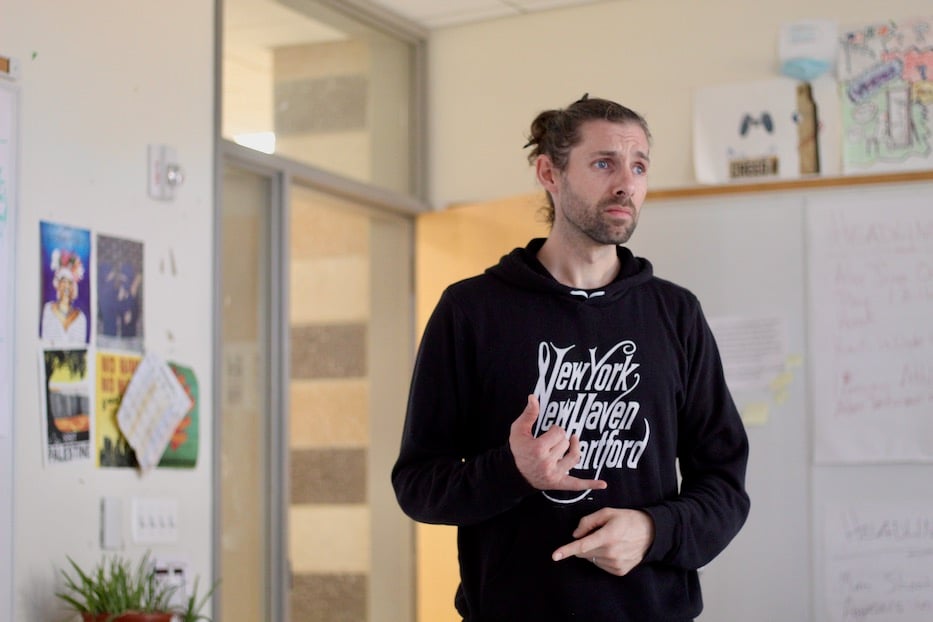
Teacher Steve Staysniak.
The Metro Monthly was originally born in December 2016, under the leadership of former Metro teacher Nataliya Braginsky. In its first issues, students wrote about citywide photo campaigns and public art projects, took their classmates’ temperatures on Hamilton and R. Kelly and the NBA, and reported on migrant caravans from Guatemala, Honduras, and El Salvador. They contributed artwork and poetry, opening up a section for creative work alongside reported stories.
Then in March 2020, Covid-19 hit New Haven, sending schools online within a matter of days. Neither Braginsky nor the school’s central office can remember when the final pre-pandemic issue hit the presses: Staysniak guessed that it was in late 2019 or very early 2020. When schools made the virtual pivot, publication screeched to a halt. It remained dormant last year, at the end of which Braginsky left the school.
When Staysniak was assigned a journalism class for the first time this year, he planned to bring the paper back to life. He’s the first to say that he’s learning alongside his students: he had never heard the term “nut graf” until a few weeks ago. In class, huge sheets of paper line the walls, scribbled with headlines from a given week. Students consume a news diet that jumps from the New York Times and NPR to the New Haven Independent and New Haven Register to TikTok.
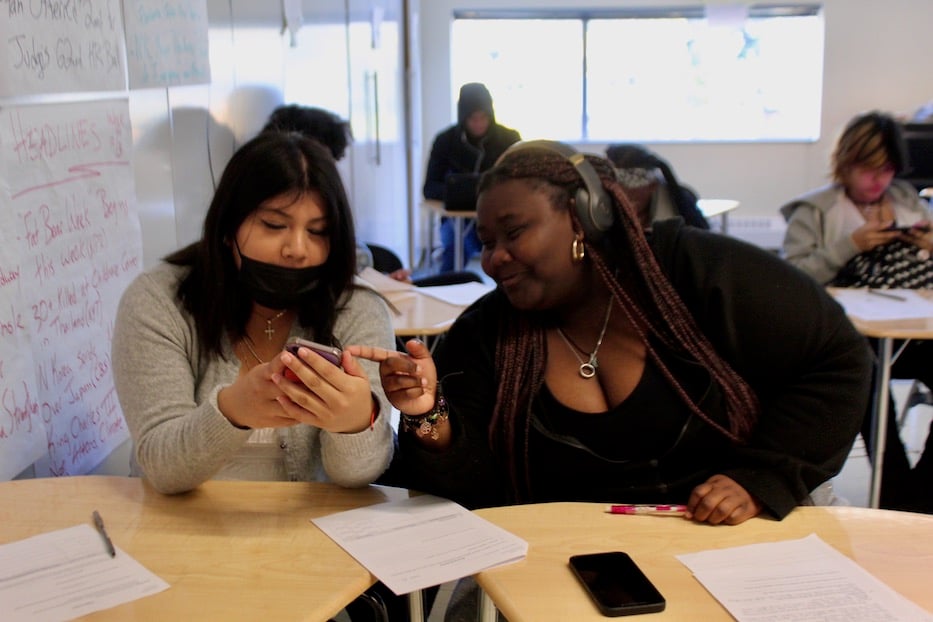
Kat Portillo and Andrea Bryant. Portillo is writing on Ye's recent antisemitism. Bryant is writing on the makerspace at the school's library.
“Some of these parts are gonna apply to you and some of them are not,” he said, pulling up a mock news story on a projector last Friday. “If you’re stuck, don’t sit stuck. Let me know and I’m gonna come help you.”
As the clock inched past 8 a.m., the class was well on its way to doing so. On a screen at the front of the room, Staysniak broke down a story paragraph by paragraph with a blue dry erase marker. Beneath a headline, he pointed out the lede and nut graph, paragraphs of supporting content and a "but" graph meant to acknowledge a contrary or other argument. To his right, large sheets of paper lined the wall with headlines from that week.
“Floyd Family Sues Kanye for $250 Million,” announced one. “Next Pandemic May Come from Glaciers,” read another. Students dutifully jotted down notes.
Around him, room 204 transformed into a newsroom, humming with conversation as new reporters split into sections. Stories hadn’t even hit the page, and already the space crackled with energy. The clock eased its hands just past 8 a.m., and students pored over their outlines, jotting down potential ledes, sources, and reporting methodology.
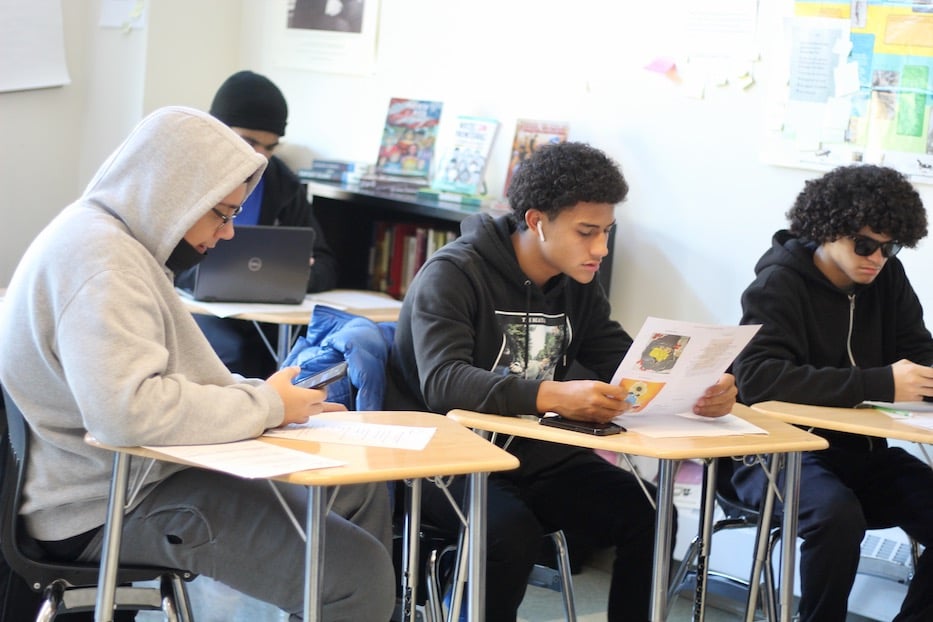
The crew behind a section on who is hiring for young people.
On one side of the room, Francisco Espada, Hector Ayala and Jojo (he declined to give his last name) hammered out the bones of a “Who's Hiring?” section, inspired by their own search for entry-level work in New Haven. Earlier this year, Ayala thought up the column when he started the job search, and realized how difficult it was for young people who didn’t have degrees and professional experience beside their names. In his friends, he heard a similar frustration.
“What I’m focusing on is jobs that hire [people] with no work experience,” he said. He started just by Googling and asking around, and went from there. Just as they would in a newsroom, they each have different tasks. Jojo, who wants to connect with the city’s Youth @ Work program, spends time scanning job websites like ZipRecruiter and Indeed for jobs that are local and will accept young people without previous experience.
“It’s hard to find a job,” he chimed in. Last summer, he tried to connect with Youth @ Work, but wasn’t able to. He’d love to see more opportunities for people his age, he said. The three are particularly interested in jobs that hire from 16 years old and up.
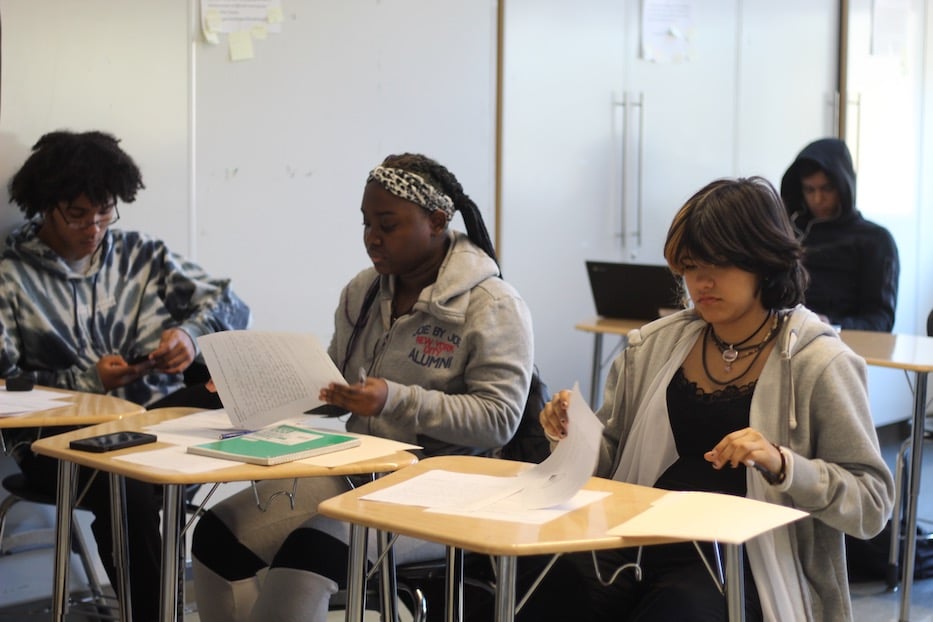
A few feet away, Kristine Figueroa figured out the best way to write on Rex Orange County, a musician who this month was charged with six counts of assault. Asher finalized their interview questions for Anne Pacelli, an English teacher who is a decades-long veteran of the New Haven Public Schools system. Back at the front of the room, Staysniak encouraged students who were having trouble to find a “mentor text”—a text that helps guide the practice, craft, and structure of writing.
“The most important thing is to ask for help,” he said. “Y’all have seen Paw Patrol before, right? What do they say?”
Layonna Miller shifted in her seat at the front of the room. Students were silent around her. “Yelp for help!” she responded when no one else spoke up.
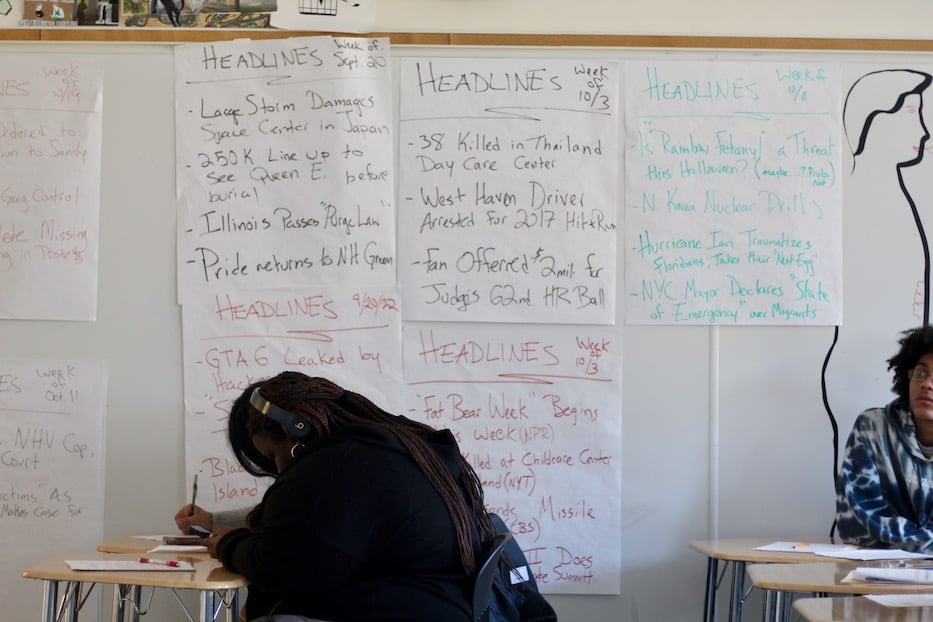
Classmates-turned-columnists Andrea Bryant and Kat Portillo traded ideas before Bryant’s foray into grassroots reporting. An aspiring lawyer, Portillo remembered feeling confused and then shocked when she first heard and then saw Kanye West, or Ye, spinning out on social media. So she decided to write about it.
First there was the “White Lives Matter” shirt. Then he suggested that George Floyd was at fault for his own murder at the hands of Minneapolis police. Then came the antisemitism, which was still developing as she tried to cover it. She struggled to keep up with the constant, 24-hour churn of news—just as real-life reporters do in their newsrooms every day. A recent class had her figuring out what to focus on, and what to leave on the cutting room floor.
“I just like heard about it, and I wanted to know how people found it antisemitic,” Portillo said, adding that she plans to interview several of her classmates to give the story a hyper-local angle. It’s an exercise for her as a listener as well, she said: she’s having trouble separating the art from the artist.
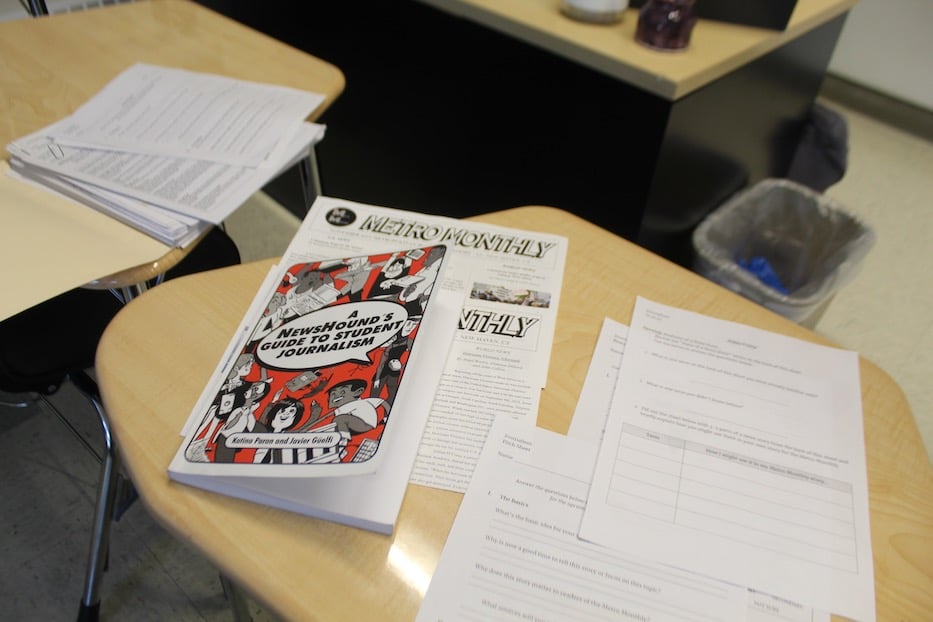
Next to her, Bryant was putting the final touches on a list of questions for school librarian, Charline Cupole. For years, Bryant has watched as students enter the library’s makerspace during lunch, and emerge with paintings, glue-and-cotton ball collages, small machine-sewed sacs, and all manner of things with googly eyes. It reminds her of how many “secret” student artists are in the school, quietly doing their thing.
“I feel like Metro doesn’t focus on people who have talent,” she said, adding that the school’s art club was discontinued a few years ago. “If you have talent, you shouldn’t hide it.”
Then Bryant was off to her first interview.
“Be Artistic and Open Up!”
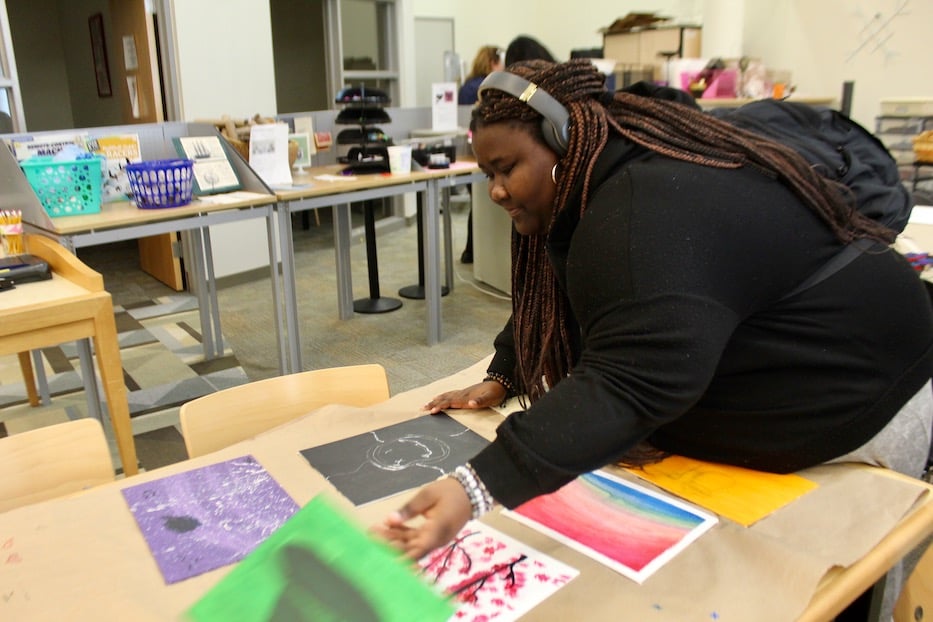
Bryant in the library, with art that has been left in the makerspace.
As she briskly walked up a flight of stairs, Bryant said she decided to cover the makerspace because it has enriched her own experience at Metro—and yet, there’s so much she still doesn’t know about it. Swinging open the library’s doors, she greeted Cupole at the front desk, and made a beeline for the space.
Tucked away into the back corner of the library, the makerspace is deceptively neat and quiet. From far away, Bryant agreed, there's no sense of the activity that lives in its few square feet. It contains two sewing machines, a Cricut machine, art supplies and enough room to spread out and store work. Stacks of discarded fabric swatches wait patiently for a creator to pick them up, and put them to use.
After looking over paintings that students had left in the space, Bryant asked Cupole if she could chat. She turned on the recording app on her phone. Her first interview lurched into motion.
“I noticed that there was a lot of kids who come here—this is their safe place,” she said. Why, she continued, did Cupole think the makerspace would work at a school like Metro?
Cupole smiled. “To give students an opportunity to express their creativity,” she said.
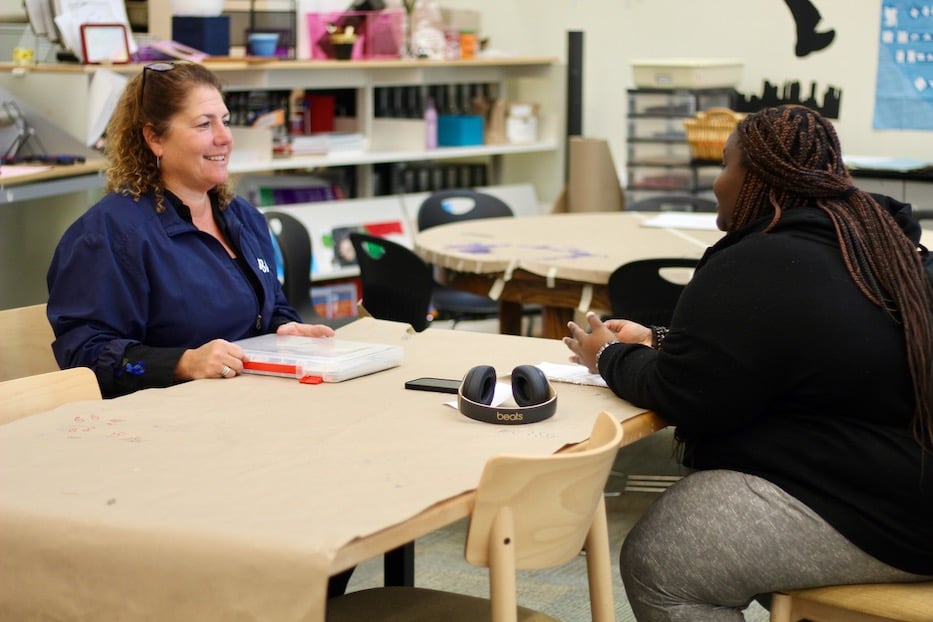
Charline Cupole: “It’s therapeutic in a way.”
Like Bryant, she noticed the number of students with an artistic bent years ago. They didn’t have a place to share that work, she said. After hearing about makerspaces at a meeting of the Connecticut Library Association roughly a decade ago, she started setting one up at the school. It spreads across a corner where shelves of books once stood.
“I saw a growing trend in public libraries,” she said. “It’s therapeutic in a way.”
Since building the space, Cupole has seen that students needed a space to express themselves, she said. Normally, they gravitate towards the paint supplies and rolls of gimp, a braidable type of plastic string, as well as specialized seasonal activities like making their own wrapping paper. A few years ago, Cupole remembered using the sewing machines, fabric swatches, and dry grains of rice to make palm-sized hand warmers.
“Would you ever start a class in the space?” Bryant asked.
“I would love to!” Cupole answered, adding that she may already be too stretched to do it. Sometimes, Cupole feels that she’s expected to be in three places at the same time, she said. “I think that’s the hurdle for me.”
She added that “in my dreamland world,” she would love to have an art class in the space. Currently, most students come into the space if they choose to spend lunch in the library, or if their class coordinates with Cupole to do an activity using the equipment and supplies. Recently, she told Bryant, a teacher brought her class in to talk about African mask making.
She looked at a series of bright paper Rangoli that the culture club had made in observance of Diwali. They now hang over the library’s front desk, welcoming students in pinks and oranges.
“I would love to infuse something with culture,” she said.
“What’s your advice for people who are secretly into art?” Bryant asked. She nearly whispered the question.
“Don’t let it be a secret!” Cupole said, her smile infectious. “It [the advice] would be not to have those fears. Be artistic and open up!”

